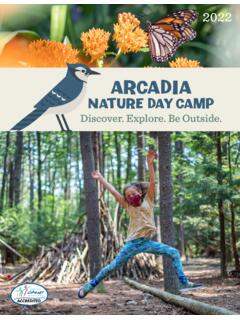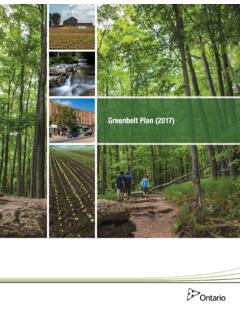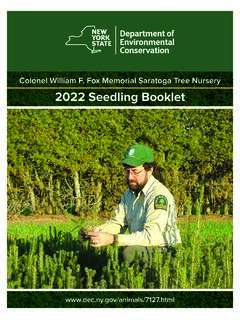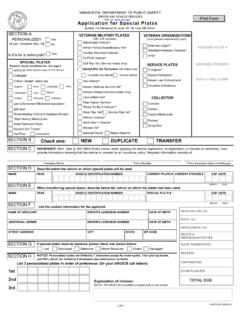Transcription of Native Plants of Massachusetts - Mass Audubon
1 Photos courtesy of , , Native Plants of Massachusetts Pine Barren communities are globally rare and support a unique suite of species. Preserving Massachusetts s Coastal Pine Barrens is vital to the conservation management of many pollinators. Globally, pollinators are in decline. You can help them by supporting the conservation of Pine Barren communities and providing nectar and pollen sources they need to survive. Butterflies and moths also rely on host Plants for food as caterpillars and for a home. Small outdoor spaces have the potential to provide quality habitat for all pollinators.
2 This guide will help you learn more about the Native Plants we included in the Tidmarsh Wildlife Sanctuary s pollinator restoration project. Below are rare and declining pollinator species that will directly benefit from these efforts. Plants selected for our restoration project are adapted to dry sandy soils which characterize their sandplain habitats in southeastern Massachusetts . Wild Indigo Baptisia tinctoria Importance: This is the larval host plant of the Frosted Elfin and Wild Indigo Duskywing. Like tumble weed, in the west, this nitrogen-fixing plant breaks off in fall and blows in the wind to spread its seeds.
3 Bloom Time: Mid-Summer What you can you do? Wild Indigo is an important pollen and nectar source for many insects. Plant it in small clusters to provide habitat for pollinators. Frosted Elfin Wild Indigo Duskywing This species has a positive relationship with ants. Rapid, erratic flight pattern. Hard to follow but it stops frequently for nectar and to bask in the sun. Photos courtesy of , , Low Bush Blueberry Vaccinium angustifolium Importance: This is the host plant of the Brown Elfin and an important early season nectar source for Native bees.
4 Berries are also consumed by most birds and mammals. Bloom Time: May-June What can you do? As well as being an important pollen source blueberry is a great garden plant. It is resistant to pests and will provide delicious berries for the family. Brown Elfin A key species to look for on an April butterfly walk, often the first to emerge. Bumblebee These large bees are important pollinators for crops. An estimated $3 billion worth of crop pollination annually to the economy. Milkweed Asclepias tuberosa Importance: Milkweeds are the only larval host plant of the Monarch butterfly.
5 Bloom Time: July-August What can you do? There are several milkweeds Native to our region. Consider planting Butterfly weed, Common Milkweed or Swamp Milkweed in your garden. Monarch The chemical composition of its milkweed makes this species poisonous to predators. Photos courtesy of , , Other Beneficial Native Plants of Massachusetts Below is a list of perennial plant species that will enhance and support pollinator habitat . These Plants provide pollinators with a source of nectar and pollen and nesting areas required to complete their life cycles.
6 Plant information includes annual bloom period and taxonomic classification with soil preferences and planting suggestions. Common Name Scientific Name Distribution Bloom Period Soil Preference Planting Suggestions Service Berry Amelanchier canadensis Native Early Spring Well drained, acidic to neutral sandy loam soils Full sun to part shade, transplant along woodland edge White Clover Trifolium repens Introduced Early Spring and Fall Cool moist, neutral to alkaline, silt to clay loam soils Full sun to part shade, plant seed only in cool moist areas at low density Common Blue Violet Viola sororia Native Early Spring Moist.
7 Neutral to alkaline silt to clay loam soils Full sun to part shade, transplant in dense clusters Tussock Sedge Carix stricta Native Spring Wet to moist, acid to neutral, silt to clay loams Full sun, transplant in and along edge of ephemeral wetland depression Bearberry Arctostaphylos uva-ursi Importance: This is the larval host plant of the Hoary Elfin. This plant is common across the Tundra. It grows low to the ground and its fruit is edible to wildlife. Bloom Time: April-June What can you do? This hardy plant grows in clusters and nutrient poor dry conditions. It s a good ground cover for full sun location in gardens.
8 Hoary Elfin In Massachusetts this species is only found in Plymouth County, the Cape and Martha s Vineyard. It can be observed in flight only in early spring. Photos courtesy of , , Common Name Scientific Name Distribution Bloom Period Soil Preference Planting Suggestions High Bush Blueberry Vaccinium corymbosum Native Spring Well drained, acid, sandy loam soils Full sun, transplant in clusters along woodland edge Low Bush Blueberry Vaccinium angustifolium Native Spring Well drained, acid, sandy loam soils Full sun, transplant in clusters Self-heal Prunella vulgaris lanceolata Native Spring Moist, neutral silt to clay loam soils Full sun to part shade.
9 Plant seed at low density Yellow Wild Indigo Baptisia tinctoria Native Early Summer Well drain, slightly acidic to neutral sandy loam soils Full sun, transplant in clusters Perennial Lupine Lupinus Perennis Native Early Summer Well drain, slightly acidic to neutral sandy loam soils Full sun, transplant in clusters Common Milkweed Asclepias syriaca Native Midsummer Moist to well drained neutral to alkaline, sandy to clay loam soils Full Sun, plant seed at low density Butterfly Weed Asclepias tuberosa Native Midsummer Well drained, acid to neutral, sandy loam soils Full sun, plant seed or transplant in clusters Joe-pye Weed Eupatorium purpureum Native Midsummer Moist to wet neutral, silt to clay loam soils Part shade to shade transplant Early Goldenrod Solidago juncea Native Midsummer Well drained to moist, neutral to alkaline, sandy loam soils Full sun to part shade plant seed at low density Cardinal Flower Lobelia cardinalis Native Midsummer Wet to moist, slightly acid to neutral, sandy to clay loam soils Full sun to shade, plant Virginia mountainmint Pycnanthemum virginianum Native Midsummer Moist to wet.
10 Alkaline, sandy to clay loam soils Part shade Common Evening Primrose Oenothera biennis Native Midsummer Well drained, acid to neutral, sandy loam soils Full sun, plant seed at low density Daisy Fleabane Erigeron annuus Native Mid to Late Summer Well drained, neutral to alkaline, sandy to clay loam soils Full sun to part shade, plant seed at low density Meadow Sweet Spiraea alba latifolia Native Mid to Late Summer Moist, neutral to slightly alkaline, clay loam soils Transplant plant in clusters Photos courtesy of , , Common Name Scientific Name Distribution Bloom Period Soil Preference Planting Suggestions Panic Grass Panicum virgatum Native Late Summer Well drained to moist, acid to neutral, sandy to clay loam soils Full sun, plant seed at low density Little Bluestem Schizachyrium scoparium Native Late Summer Well drained, acid to neutral, sandy loam soils Full sun, plant seed at high density Purpletop Tridens flavus Introduced Late Summer Well drained, acid to neutral, sandy to clay loam soils Full sun to part shade.








